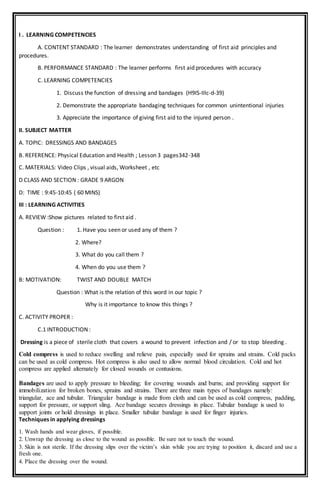
Essential First Aid Skills: Dressings and Bandaging Techniques
- 1. I . LEARNING COMPETENCIES A. CONTENT STANDARD : The learner demonstrates understanding of first aid principles and procedures. B. PERFORMANCE STANDARD : The learner performs first aid procedures with accuracy C. LEARNING COMPETENCIES 1. Discuss the function of dressing and bandages (H9IS-IIIc-d-39) 2. Demonstrate the appropriate bandaging techniques for common unintentional injuries 3. Appreciate the importance of giving first aid to the injured person . II. SUBJECT MATTER A. TOPIC: DRESSINGS AND BANDAGES B. REFERENCE: Physical Education and Health ; Lesson 3 pages342-348 C. MATERIALS: Video Clips , visual aids, Worksheet , etc D CLASS AND SECTION : GRADE 9 ARGON D: TIME : 9:45-10:45 ( 60 MINS) III : LEARNING ACTIVITIES A. REVIEW :Show pictures related to first aid . Question : 1. Have you seen or used any of them ? 2. Where? 3. What do you call them ? 4. When do you use them ? B: MOTIVATION: TWIST AND DOUBLE MATCH Question : What is the relation of this word in our topic ? Why is it importance to know this things ? C. ACTIVITY PROPER : C.1 INTRODUCTION : Dressing is a piece of sterile cloth that covers a wound to prevent infection and / or to stop bleeding . Cold compress is used to reduce swelling and relieve pain, especially used for sprains and strains. Cold packs can be used as cold compress. Hot compress is also used to allow normal blood circulation. Cold and hot compress are applied alternately for closed wounds or contusions. Bandages are used to apply pressure to bleeding; for covering wounds and burns; and providing support for immobilization for broken bones, sprains and strains. There are three main types of bandages namely: triangular, ace and tubular. Triangular bandage is made from cloth and can be used as cold compress, padding, support for pressure, or support sling. Ace bandage secures dressings in place. Tubular bandage is used to support joints or hold dressings in place. Smaller tubular bandage is used for finger injuries. Techniques in applying dressings 1. Wash hands and wear gloves, if possible. 2. Unwrap the dressing as close to the wound as possible. Be sure not to touch the wound. 3. Skin is not sterile. If the dressing slips over the victim’s skin while you are trying to position it, discard and use a fresh one. 4. Place the dressing over the wound.
- 2. 5. Use a dressing that is large enough to extend at least 1 inch beyond the edges of the wound. 6. If body tissue or organs are exposed, cover the wound with a dressing that will stick. 7. Then secure the dressing with a bandage or adhesive tape. Integration : Mathematics Figure 2 shows the parts of a triangular bandage. Two Phases of Bandaging A. An open phase bandaging is used for wounds on top and back of the head, chest, back, hand, and foot, and as arm sling. B. A cravat phase bandaging is used for wounds that need extra support like wound on the eye, forehead, ear, cheek, jaw, shoulder, hip, arm, leg, elbow, knee, and palm and for a sprained ankle. The narrower the cravat is, the greater pressure it will give. Techniques in Bandaging 1. Keep in mind the following: a. Always use a square knot. b. Keep the cloth sterile to avoid infection. c. Always keep the ends. 2. Bandaging technique depends upon the size and location of the wound, your first aid skills, and materials at hand. 3. Bandage firmly over bleeding and securely over the broken bone, not so tight so as not to cut off blood circulation. 4. When wrapping bandages around the body, such as knees, ankles, neck, and small back , use its natural hollows to slide the bandage gently into place. 5. Since most injuries swell, check regularly to ensure that the bandage is still comfortable and that it remains firmly secured. 6. Secure the bandage with a tape, clips or a bow or square knot. Ensure that the bandages, especially the knots, do not touch the skin. B ACTIVITY : Proper folding and bandaging Perform the activity based on their grouping Let the group showcase their work Do this within 10 mins C. ANALYSIS: 1. Why we should use dressings and bandages on wounds? 2. Can we use any cloth as a dressings and bandage? Why and Why not ? 3. Aside from wounds , in what other injuries can we use dressing and bandages ?
- 3. D. ABSTRACTION : Why is it necessary to apply the proper techniques on applying dressings and bandages ? E. APPLICATION: Name some materials at home or in school that can be used as dressings and bandages. . Include their uses and importance. IV Evaluation: 1. Why should we use dressing and bandages ? V , ASSIGNMENT: 1. How will you bring the victim to a safe place ? 2. Answer Diagnostic Assessment on page 321 in a whole sheet of paper ? Prepared by : VERNA ALERTA ARCO MAPEH 9 Teacher
